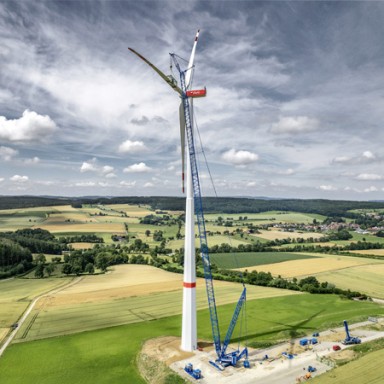Latest news
News and press releases
06/11/2024News
MyGuide for Earthmoving App: exclusive insights into the construction of the Liebherr BAUMA booth
At the moment, everything still looks inconspicuous on the grounds of the Munich exhibition centre and there is little to suggest the world's largest construction machine trade fair. However, preparations are already underway so that the first visitors can visit Liebherr at BAUMA 2025 in just under six months.
06/11/2024Press releases
MSG expands large crane fleet with Liebherr
MSG Krandienst GmbH, based in the Franco-German border region near Strasbourg, is expanding its fleet of large cranes with two modern machines from the Liebherr plant in Ehingen. An LTM 1300-6.3 was received a few days ago. This will be followed in February by an LTM 1650-8.1 with extensive equipment and the two telescopic boom variants with lengths of 54 and 80 metres. The company with the distinctive blue cranes believes it is well positioned to meet the requirements of the cross-border Alsace-Baden region.
05/11/2024Press releases
Winter wonders: Liebherr wheel loaders as versatile helpers in snow and ice
Winter brings snow and ice that can make roads and pavements impassable. Reliable and powerful machines are essential to keep the infrastructure going. Thanks to their performance and robustness, Liebherr wheel loaders are also indispensable helpers for winter road maintenance. Various working attachments also enable a wide range of uses.
04/11/2024Press releases
Mota-Engil orders 10 Liebherr railroad excavators for a major project in West Africa
The Portuguese construction company Mota-Engil has once again opted for Liebherr railroad excavators. The ten new machines of the type A 922 Rail Litronic will be used for a major railway project in Nigeria and Niger.
04/11/2024Press releases
First in the fleet: Grúas Pirineos invests in a Liebherr LTM 1650-8.1 mobile crane
For Grúas Pirineos, the purchase of its first Liebherr mobile crane, the LTM 1650-8.1, marks a true milestone in the company’s short history. Thanks to this new acquisition, it can now offer a comprehensive range of services to its customers. The Liebherr LTM 1650-8.1 will be primarily used by Grúas Pirineos in the wind energy, industrial and construction sectors.
Magazines by Liebherr
Exhibitions and events
05/11/2024 - 07/11/2024Exhibitions
05/11/2024 - 07/11/2024Exhibitions
05/11/2024 - 10/11/2024Exhibitions
07/11/2024 - 10/11/2024Exhibitions
08/11/2024Exhibitions
"Arbeit ist Zukunft - informiere dich jetzt !"
Continue reading

Our year in figures
Published every year, our Annual Report looks back in detail at the past financial year. Find out facts, figures and stories from the Group.

Shaping digital transformation
Whether it is IoT, machine learning or cloud applications – discover Liebherr’s wide range of digital solutions.

All about wind energy
As a strong partner to the wind industry, Liebherr offers the right solution for a wide range of requirements.

Social Media
Find your community among Liebherr's many social media channels.